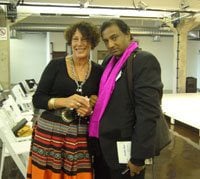
Subscribe & Follow
#AfricaMonth
Jobs
- Sales Consultant Hazyview
- Field Agent Nelspruit
- Store Manager East London
- Fashion Graphic Designer Cape Town
- Regional on Premise Manager East London
- Distribution Partner Manager - Non-Liquor East London
- Sales Representative Pietermaritzburg
- Commercial Head (Beverages) Johannesburg
- Distribution Partner Manager - Liquor Johannesburg
- Sales and Brand Excutive Cape Town
In the news
Good design is not all feathers and sequins...

The issue of sustainability is a common thread that ran through the speakers' presentations at the opening day of the inaugural Fashion Exchange +27, held at The Runway, from 29-30 May 2008. Created by SA design industry guru Gavin Rajah and Tziona Aronson, the annual event has been launched as a platform for the fashion industry with a view beyond the runway and cutting room floor, while bringing industry players together to freely interact and exchange ideas.
During his welcome address, Rajah posed the question: People, profit and environment - how do we design around these factors and still maintain sustainability?
On maintaining a luxury brand, Carol Morgan, global trend tracker and fashion marketer, said that it takes more than just money to create a successful brand - it's about having a sustainable product and a unique selling point. Calling sustainable design the antidote to fast fashion, she said that good design is not all about styling; it's about making something that works properly. Good design is not all bells and whistles, ostrich feathers and sequins - sometimes simple is better.
Morgan says that in order to build your brand, you need to understand your core value, and successfully communicate that to your target market. Ask yourself: Is my vision clear to customers - do they know what I am trying to say?
Giovanni Lepori, who has notable experience in working with famous brands such as Christian Dior and Prada, said that what sustains successful brands is a combination of a strong creative and a strong business mind - and not necessarily in the same person.
Talking about investment in the fashion industry, Lepori highlighted a few brands that have sustained and even grown in stature by taking on outside investment.
Jimmy Choo is one of these success stories, having grown from a one-store women's luxury shoe brand in London obscurity, circa 1996, to 23 stores, before selling to Lion Capital in 2004 for 101 million pounds. Under Lion's guidance, this sought-after global fashion statement (ala Sex and the City) expanded to 60 branded stores worldwide. Three years later, Lion Capital sold the brand onto TowerBrook Capital for 185 million pounds. Although fiercely loyal to its core product, the brand is now branching out beyond shoes to include other accessories such as handbags, sunglasses and even perfume in their range.
Lepori said that the mark of a good brand is its sustainability of its core product. He said that a common factor of failed investment is the over-expansion and dilution of its core. In the case of Helmut Lang, Prada discontinued the main line of denim-wear, and that kicked off the decline of the brand.
Lepori echoed Morgan in saying that throwing money at something doesn't necessarily grow a business; but that season in - season out, a sustainable brand is something on which you can rely.
Related
Next-gen materials to reach 8% of fibre market by 2030 14 Apr 2025 Entries open for 2025 allfashion sourcing Young Designer Competition 20 Feb 2025 #WomensMonth: Isabel de Villiers on fashion as empowerment 6 Aug 2024 West Africa’s fashion designers are world leaders when it comes to producing sustainable clothes 17 Apr 2024 SA’s fashion industry yields highest sales in sub-Saharan Africa of $11bn 26 Mar 2024











